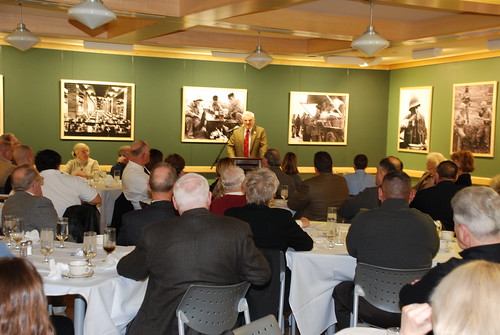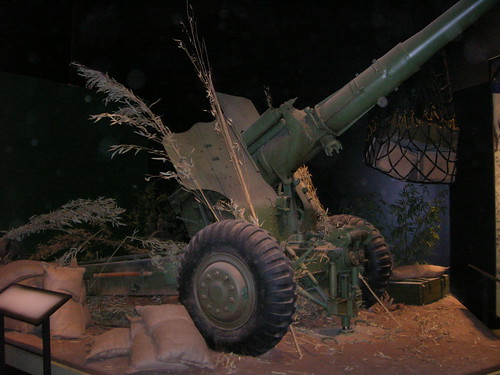Col. Wesley Fox (ret) shared his experiences as a company commander during Operation Dewey Canyon with a crowd of about 100 at a dinner held at the National Museum of the Marine Corps.
In January 1968, the North Vietnamese Army along with the Viet Cong, staged the Tet Offensive. It was hoped that the South Vietnamese would rise up in support of their northern brothers against the Americans. This didn't happen. Tactically, it was a huge defeat for the VC and NVA. For the Americans, who had been told by the US government that we were winning the war, it was also a defeat. After all, how could the NVA and VC launch such an attack when they were being defeated?
The following year, January 1969, things were pretty quiet. The combat fire bases were still taking hits from the NVA, but the Marines were not going outside the wire to engage the enemy. As Fox put it, we were engaging the enemy at a time and place that was convenient for the enemy.
As in years past, military intel could see the NVA pre-positioning supplies and building roads heading south in neighboring Laos. Marine Corps leadership decided to take the fight to the enemy and disrupt whatever it was the NVA was planning. This "take-it-to-the-enemy" was Operation Dewey Canyon.
I'm going to pull from my notes from Col. Fox's talk and from an article Vietnam War: Operation Dewey Canyon from HistoryNet.
According the HistoryNet, as many as 1000 trucks a day were observed heading south on Route 922 in Laos. They were moving supplies to locations in South Vietnam. In addition, movement at a NVA base within Laos suggested that large numbers of regular forces were moving into the A Shau Valley. The NVA would pre-position supplies along forward operating areas so that they could quickly supply troops when launching attacks. Gen. Raymond Davis, commander of the 3rd Marine Division, did not like the idea of watching all these supplies head south where it could be used to kill Americans.
How to stop the supplies? This was difficult because the NVA was operating from within Laos, which was a neutral country.
The decision was made that under the current rules of engagement, that the Marines could attack the NVA in Laos in self defense. According to Fox, everything that the Marines were about to do was completely unexpected. They were going to attack during monsoon season, in dense jungle. The dense jungle itself provided quite the obstacle. In order for helicopters to drop in troops, supplies and pick-up the wounded, the Marines would have to clear landing zones. The fact that this was monsoon season, meant the clouds were too low most of the time for air to come in and support the Marines. The NVA wouldn't expect the US to launch an operation they couldn't support by air.
"The difficult we do immediately, the impossible takes a little longer." Col. Fox chuckled.
The operation was going to be so difficult that the war dogs had to be evacuated. It was too hot for the dogs and they would not be able to carry enough water to support them. Yep, how ironic is that? The dogs were out but the Marines were still in
Prior to 'jumping off' the 9th Marines had the opportunity to train while it waited at Vandergrfit Combat Base. Fox said his men were looking forward to resting so were not happy that he decided to 'school' them. The difference between the units in Vietnam and those in Iraq and Afghanistan today, was thatthe units in Vietnam didn't get a chance to train as a unit prior to deployment. Replacements would come in individually. They didn't have an opportunity to learn what to expect from each other. They were well trained Marines, just not as a unit. So, Fox explained to his men that his goal with 'schooling' was to send them back on the Freedom Bird, not in caskets. This kind of warmed them up to unit training.
This training came in handy when on February 22, Fox's company ran into a heavily fortified NVA bunker complex. Fox's command group took a direct hit from a mortar round, which killed or wounded everyone, except for the executive officer. All of his platoon leaders lost, radio operators dead and himself wounded, Fox took control of the radios giving orders to his men. He said that four weeks of training at Vandergrift had paid off because his Marines knew what was expected of them and what they could expect out of each other. The squad leaders took charge and when they went down, the Marines still knew what to do.
Fox had two options: 1) He could break contact and get out or 2) commit his reserve platoon. He was leaning toward option #1, however, he was afraid he wouldn't be able to get his wounded out because he didn't think he had enough able bodied me to carry them. It could take at least four, up to 10 men to carry a wounded man out through the hills and jungle on a poncho liner. He chooses option 2 and commits his reserve platoon. He said when he was about at wits end, the sun broke through and he was finally able to call in air suppport, which took out the NVA machine guns.
When the fight was over, Fox's company, which had gone in with just 90 Marines, 54 Marines were wounded and 11 Marines had been killed, 105 NVA dead were recovered. Yes, I know 90 is far short of the number of been in a company. One of his platoons had been called back to help guard two 122mm guns that had been captured several days earlier. There was some fear that the NVA would stage an assult to recapture them.
(Above, one of the 122mm guns captured during Operation Dewey Canyon.)
Later, on Hill 1044, a Marine set off to relieve himself in a bomb crater. As he was digging his hole, his entrenching tool hit a wood crate. The Marines ended up uncovering a large weapons cache and discovered that the NVA was burying their weapons in bomb craters.
For Fox, Operation Dewey Canyon was an eye opener, he was ready to go home when it was all over. Fox was awarded the Medal of Honor for his actions in this operation.
According to HistoryNet and Col Dick Camp at the conclussion of Col Fox's talk, Operation Dewey Canyon was considered one of the best regimental maneuvers of the Vietnam War. The statistics: 1,617 NVA were killed, while 130 Marines lost their lives and 920 were wounded. The Marines had disrupted a major NVA logistics center, captured tons of weapons, ammunition and food. Because of Operation Dewey Canyon, the NVA was unable to launch any offensive into I Corps that YEAR.
Unfortunately, at the end of the operation, the NY Times reported the incursion into neutral Laos. Anti-war groups were up in arms. The Secretary of Defense didn't confirm or deny the incursion however, the US ambassador to Laos apologized for the incident.









No comments:
Post a Comment